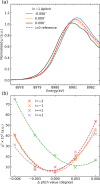Five-analyzer Johann spectrometer for hard X-ray photon-in/photon-out spectroscopy at the Inner Shell Spectroscopy beamline at NSLS-II: design, alignment and data acquisition
- PMID: 39475836
- PMCID: PMC11542649
- DOI: 10.1107/S1600577524009342
Five-analyzer Johann spectrometer for hard X-ray photon-in/photon-out spectroscopy at the Inner Shell Spectroscopy beamline at NSLS-II: design, alignment and data acquisition
Abstract
Here, a recently commissioned five-analyzer Johann spectrometer at the Inner Shell Spectroscopy beamline (8-ID) at the National Synchrotron Light Source II (NSLS-II) is presented. Designed for hard X-ray photon-in/photon-out spectroscopy, the spectrometer achieves a resolution in the 0.5-2 eV range, depending on the element and/or emission line, providing detailed insights into the local electronic and geometric structure of materials. It serves a diverse user community, including fields such as physical, chemical, biological, environmental and materials sciences. This article details the mechanical design, alignment procedures and data-acquisition scheme of the spectrometer, with a particular focus on the continuous asynchronous data-acquisition approach that significantly enhances experimental efficiency.
Keywords: Johann geometry; X-ray emission spectrometers; X-ray spectroscopy.
open access.
Figures








References
-
- Albrahim, M., Thompson, C., Leshchev, D., Shrotri, A., Unocic, R. R., Hong, J., Hoffman, A. S., Meloni, M. J., Runnebaum, R. C., Bare, S. R., Stavitski, E. & Karim, A. M. (2021). J. Phys. Chem. C, 125, 11048–11057.
-
- Allan, D., Caswell, T., Campbell, S. & Rakitin, M. (2019). Synchrotron Radiat. News, 32(3), 19–22.
-
- Amidani, L., Naldoni, A., Malvestuto, M., Marelli, M., Glatzel, P., Dal Santo, V. & Boscherini, F. (2015). Angew. Chem. Int. Ed.54, 5413–5416. - PubMed
Grants and funding
LinkOut - more resources
Full Text Sources

